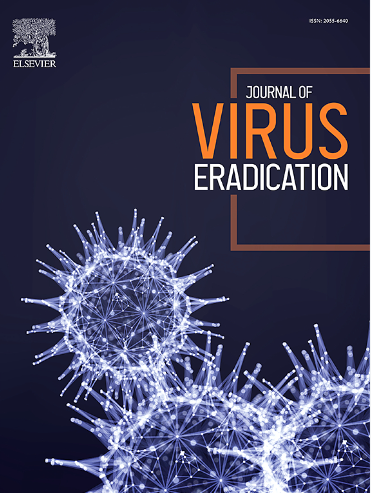对孟加拉国出现尼帕病毒暴发的一般人群知识的评估:一项全国性横断面研究
IF 2
4区 医学
Q2 IMMUNOLOGY
引用次数: 0
摘要
尼帕病毒的出现对全球健康构成重大威胁,特别是在东南亚国家。这项横断面全国性研究是评估孟加拉国普通人群中NiV爆发知识水平的先驱。该研究于2024年1月15日至2月10日在孟加拉国的一般人口中进行。一个方便选择的个人样本参与了他们对NiV知识的评估。采用半结构化问卷作为数据收集工具。数据整理后,总共保留了2121份符合纳入标准的回复进行分析。在2121名参与者中,69.38%的人知道NiV。总的来说,62%的人表现出对病毒有良好的了解。主要信息来源为社交媒体(29.9%)、电视(25.41%)、教育机构(18.95%)、报纸(13.65%)、朋友(6.39%)、工作场所(5.91%)。多因素logistic回归分析显示,31-40岁的参与者知识贫乏的几率较低(OR = 0.57, 95% CI: 0.39-0.82, p <;0.01)。女性知识贫乏的几率高于男性(OR = 1.38, 95% CI: 1.05-1.81, p = 0.02)。受教育程度越低,知识贫乏的几率越大。此外,与卫生保健工作者相比,非卫生保健工作者知识贫乏的几率也更高。存在地区差异,在Rangpur有不同的赔率(OR = 0.43, 95% CI: 0.26-0.70, p <;0.01),战争怎样惊人地扩大(OR = 1.70, 95% CI: 1.10—-2.61,p = 0.01),和Mymensingh (OR = 2.77, 95% CI: 1.70—-4.53,p & lt;0.01)。目前的研究强调了以证据为基础的教育战略的重要性,并可能指导政府和决策者设计未来有针对性的干预措施,以提高公众卫生素养,并减轻NiV在孟加拉国及其邻国的传播。本文章由计算机程序翻译,如有差异,请以英文原文为准。

Assessment of the general population knowledge about the emergence of Nipah virus outbreak in Bangladesh: A nationwide cross-sectional study
The emergence of the Nipah virus (NiV) poses a significant global health threat, particularly in South-East Asian countries. This cross-sectional nationwide study is a pioneer in assessing knowledge levels of NiV outbreak among the general population in Bangladesh. It was conducted among the general population of Bangladesh from 15th January to 10th February 2024. A conveniently selected sample of individuals participated in the assessment of their knowledge about NiV. A semi-structured questionnaire was used as the data collection tool. After data curation, a total of 2121 responses that met the inclusion criteria were retained for analysis. Among 2121 participants, 69.38 % were aware of NiV. Overall, 62 % demonstrated good knowledge of the virus. The main sources of information were social media (29.9 %), television (25.41 %), educational institutions (18.95 %), newspapers (13.65 %), friends (6.39 %), and workplaces (5.91 %). Multivariate logistic regression analysis showed that participants aged 31–40 years had lower odds of poor knowledge (OR = 0.57, 95 % CI: 0.39–0.82, p < 0.01) compared to those aged 21–30. Females had higher odds of poor knowledge (OR = 1.38, 95 % CI: 1.05–1.81, p = 0.02) than males. Lower education levels were associated with higher odds of poor knowledge. Moreover, non-healthcare workers also had higher odds of poor knowledge compared to healthcare workers. There were regional differences, with varying odds in Rangpur (OR = 0.43, 95 % CI: 0.26–0.70, p < 0.01), Khulna (OR = 1.70, 95 % CI: 1.10–2.61, p = 0.01), and Mymensingh (OR = 2.77, 95 % CI: 1.70–4.53, p < 0.01) compared to Dhaka. The current study underscores the importance of evidence-based educational strategies, and may guide government and policymakers to design future targeted interventions to enhance public health literacy and mitigate the spread of NiV in Bangladesh as well as in its neighbouring countries.
求助全文
通过发布文献求助,成功后即可免费获取论文全文。
去求助
来源期刊

Journal of Virus Eradication
Medicine-Public Health, Environmental and Occupational Health
CiteScore
6.10
自引率
1.80%
发文量
28
审稿时长
39 weeks
期刊介绍:
The Journal of Virus Eradication aims to provide a specialist, open-access forum to publish work in the rapidly developing field of virus eradication. The Journal covers all human viruses, in the context of new therapeutic strategies, as well as societal eradication of viral infections with preventive interventions.
The Journal is aimed at the international community involved in the prevention and management of viral infections. It provides an academic forum for the publication of original research into viral reservoirs, viral persistence and virus eradication and ultimately development of cures.
The Journal not only publishes original research, but provides an opportunity for opinions, reviews, case studies and comments on the published literature. It focusses on evidence-based medicine as the major thrust in the successful management of viral infections.The Journal encompasses virological, immunological, epidemiological, modelling, pharmacological, pre-clinical and in vitro, as well as clinical, data including but not limited to drugs, immunotherapy and gene therapy. It is an important source of information on the development of vaccine programs and preventative measures aimed at virus eradication.
 求助内容:
求助内容: 应助结果提醒方式:
应助结果提醒方式:


